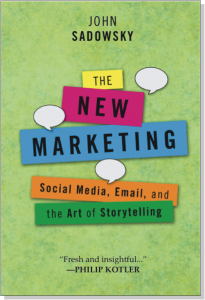
This week, I am back in one of my very favorite cities, Buenos Aires. Just a few weeks ago, at a meeting with my publisher here to discuss another printing of the book, Las Siete reglas del storytelling (Ediciones Granica), they inquired about the possibility of translating another of my books—The New Marketing: social media, email and the art of storytelling.
At first, I was uncertain about the viability of this particular project, as this book was written six or seven years ago. Since that time, uses of the internet for e-marketing purposes have evolved considerably, and I suspected that parts of my book would appear outdated. As such, I asked for some time to re-examine the text before I would sit down to draft any agreement about an edition in Spanish.
The people of Ediciones Granica told me that they thought the text would need only small adaptations, and I was somewhat surprised to realize how correct they were in that assessment. In his endorsement of the book, author Seth Kahan wrote in 2011 that it contains “a lasting message which will be a source of inspiration and motivation for many years to come”.
If the book’s core concepts do provide lessons that remain relevant today, it is due to a simple decision I made when I began working on it. I wanted this work to be not so much about technologies that were changing the world of marketing, nor about trends, techniques and best practices in the field at the time. Instead, I sought to express what I saw as two essential and enduring truths:
First, in a time when marketing practices and strategies are changing rapidly, the best way to win people’s attention and trust will continue to be authentic storytelling around a brand. And second, the internet—in particular social media—provides an extremely powerful platform for reaching potential users and inspiring them to act.
So, when I reread the book this week, I was pleased to recall that my goal had never been to capture and analyze a moment in time, but rather to explore how the enduring principles of branding apply in the “new” world of e-commerce.
In fact, when I was researching and writing the first edition of Email, social marketing and the art of storytelling in 2011, I made a point of telling people that it was not my intention to report on the “state of the art” of digital marketing. My feeling was that such an endeavor—an attempt to capture what was new and trending at the time—was neither possible nor particularly useful. Any treatise on social media and email marketing would be quickly outdated, I reasoned, since this world was literally transforming itself every day.
Nor was the book intended to be a portrayal of the best practices in internet marketing. From the outset, my purpose was not to write about the extraordinary accomplishments of star companies, but rather to show some of the everyday practices of companies that everyone can relate to. It was my hope that the book would stimulate thought and discussion about how any organization can strengthen its brand and build its user community, through the combination of email, social media and storytelling.
As such, the organizations I cite as in-depth examples have neither enormous notoriety nor vast marketing resources. They would certainly not be considered hot, trendy or sexy. Nonetheless, quite a few of them achieved remarkable results by combining storytelling and digital media. They serve as proof that the practices I describe for building brands and organizing brand communities can be utilized by anybody.
One of the advantages I had when looking for stories to tell in the book was that many examples could come directly from my consulting clients. As my reflection progressed with regard to what companies I should include, a central decision emerged: the book should be straightforward and accessible, with a multitude of stories in which readers could “see” themselves and their organizations. I wanted a wide cross-section of people to read the examples and think, “We could do things like that.” To this end, I chose many illustrations from businesses whose products or services we might use in the course of our daily lives.
So, when I picked up the book again, I was pleased to see that its concepts and examples remain completely applicable in today’s world. And, I am happy to report that we will now embark on the always stimulating project of bringing a new edition/translation into the world.
